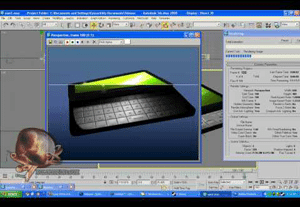Today, aesthetics play pivotal role as a key product differentiator. 3D scanning and modelling provides designers with a shorter and smarter way to create newer concepts. Next-generation 3D laser scanners showcase high accuracy, portability, ease of use and integration with 3D modelling software tools
SHWETA DHADIWAL BAID
MAY 2011: What is the difference between HTC’s Hero and Motorola’s Flipout Square mobile phones? Though both are Android phones with innovative design—Hero with an angled chin and Flipout with a square shape—there is a huge difference in user experience while using the same software on a smaller screen (where you have to scroll down often to view the menu) and also in the placement of the microphone and speakers.
In order to improvise any existing product, designers need to create its 3D model by reverse engineering. This is where 3D scanning comes into play. Earlier more applicable for mechanical engineers engaged in computer-aided design, it is today very important for embedded design engineers too to understand the industrial design of the product.
According to Rahul Singh, senior designer from Longcheer, “3D measurement is a technique to analyse and measure the existing objects, which helps while developing a new concept taking an inspirational motivation from the existing objects.”
A wide range of applications including robotics, aeronautics, medical electronics, gaming and biometrics require acquisition of the three-dimensional geometry of a shape to sustain competition of the aesthetics. Many of these applications require the 3D data to be captured in real time.

Getting a low-cost, high-speed, real-time 3D scanner has always been a challenge despite the availability of different acquisition methods. Today, there are a number of portable laser scanners available in the market. Some of the latest technologies that go in today’s scanners include ARM processor and digital light processing (DLP).
3D measurements: scanning and modelling
Three-dimensional measurements are carried out along all three axes and used to understand the geometry of an object for redesigning, reverse engineering, modelling of existing products, creating concepts and more. 3D scanning helps in gathering the required data to model your imagination. To realise a concept and share your imagination with others, 3D modelling helps a great deal.
3D scanning is a process which analyses the real-world object and collects the data on its shape and appearance. The scanners are similar to cameras but the purpose of a 3D scanner is different in the way it produces point-cloud data of the surface of the geometry.
“When you move a 3D scanner above an object, it collects information about the surfaces which are not hidden. The camera collects the colour information about the surfaces, whereas the 3D scanner collects the information about the distance of the various points lying on that surface,” explains Singh.
On combining all the data point values, you get a three-dimensional coordinate system for each point, which is good enough to use in any 3D modelling software to generate a well-defined surface. For 3D scanning you need a 3D scanner machine and software to port the scanned data, while for 3D modelling you require the 3D data and 3D modelling software.
In electronic products, quite often the space is limited. Dr Vinay Vaidya, chief technology officer, Engineering & CREST Leader, KPIT Cummins, says, “Fitting the electronics in a given space is a challenge. 3D scanning gives a clear idea about not only the length and width but also the height. Knowing the height of each component gives freedom to the designer in selecting a substitute component meeting the same height constraint. Space available inside the casing is also important from overall cooling perspective.”
For most situations, a single scan does not produce a complete model of the subject. Singh says, “Multiple scans, even hundreds, from many different directions are usually required to obtain information about all sides of the subject.”
3D model: Reduce cost, develop faster
The cost of product development is increasing with the demand for compact design and multiple functionalities. 3D modelling gives conceptual design, engineering, manufacturing and sales and marketing departments the ability to virtually explore the complete product before it is built.
[stextbox id=”info” caption=”3D laser scanners & scanning services vendors”]• Handysan
• Konica Minolta
• Mitutoyo
• NextEngine
• Proto3000
• Stienbichler
• Zeiss
• 3Shape
• Artec
• Breukmann
• Capture3D
• Creaform
• Davidscan
• Faro
• GKS[/stextbox]
Ram Bahadur Diwan, a senior designer at Longcheer, explains, “Traditionally, the product development cycle is design→build→test→fix, while in the case of 3D modelling product development steps are design→analyse→test→build. By using 3D modelling to catch design problems upfront, manufacturers experience fewer change orders downstream.”







